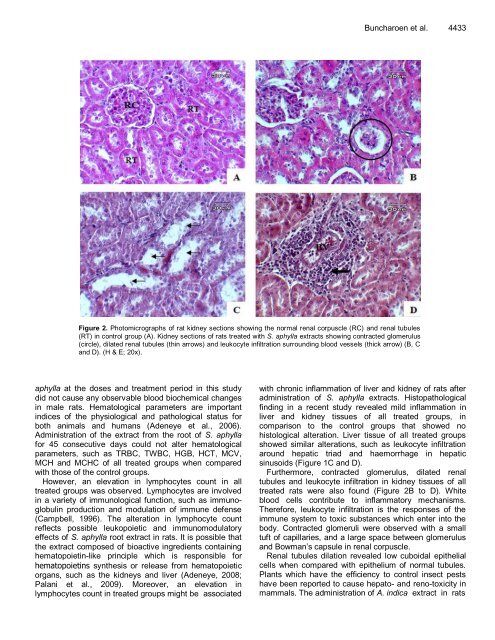Download Complete Issue (4740kb) - Academic Journals
Download Complete Issue (4740kb) - Academic Journals
Download Complete Issue (4740kb) - Academic Journals
Create successful ePaper yourself
Turn your PDF publications into a flip-book with our unique Google optimized e-Paper software.
Buncharoen et al. 4433<br />
Figure 2. Photomicrographs of rat kidney sections showing the normal renal corpuscle (RC) and renal tubules<br />
(RT) in control group (A). Kidney sections of rats treated with S. aphylla extracts showing contracted glomerulus<br />
(circle), dilated renal tubules (thin arrows) and leukocyte infiltration surrounding blood vessels (thick arrow) (B, C<br />
and D). (H & E; 20x).<br />
aphylla at the doses and treatment period in this study<br />
did not cause any observable blood biochemical changes<br />
in male rats. Hematological parameters are important<br />
indices of the physiological and pathological status for<br />
both animals and humans (Adeneye et al., 2006).<br />
Administration of the extract from the root of S. aphylla<br />
for 45 consecutive days could not alter hematological<br />
parameters, such as TRBC, TWBC, HGB, HCT, MCV,<br />
MCH and MCHC of all treated groups when compared<br />
with those of the control groups.<br />
However, an elevation in lymphocytes count in all<br />
treated groups was observed. Lymphocytes are involved<br />
in a variety of immunological function, such as immunoglobulin<br />
production and modulation of immune defense<br />
(Campbell, 1996). The alteration in lymphocyte count<br />
reflects possible leukopoietic and immunomodulatory<br />
effects of S. aphylla root extract in rats. It is possible that<br />
the extract composed of bioactive ingredients containing<br />
hematopoietin-like principle which is responsible for<br />
hematopoietins synthesis or release from hematopoietic<br />
organs, such as the kidneys and liver (Adeneye, 2008;<br />
Palani et al., 2009). Moreover, an elevation in<br />
lymphocytes count in treated groups might be associated<br />
with chronic inflammation of liver and kidney of rats after<br />
administration of S. aphylla extracts. Histopathological<br />
finding in a recent study revealed mild inflammation in<br />
liver and kidney tissues of all treated groups, in<br />
comparison to the control groups that showed no<br />
histological alteration. Liver tissue of all treated groups<br />
showed similar alterations, such as leukocyte infiltration<br />
around hepatic triad and haemorrhage in hepatic<br />
sinusoids (Figure 1C and D).<br />
Furthermore, contracted glomerulus, dilated renal<br />
tubules and leukocyte infiltration in kidney tissues of all<br />
treated rats were also found (Figure 2B to D). White<br />
blood cells contribute to inflammatory mechanisms.<br />
Therefore, leukocyte infiltration is the responses of the<br />
immune system to toxic substances which enter into the<br />
body. Contracted glomeruli were observed with a small<br />
tuft of capillaries, and a large space between glomerulus<br />
and Bowman’s capsule in renal corpuscle.<br />
Renal tubules dilation revealed low cuboidal epithelial<br />
cells when compared with epithelium of normal tubules.<br />
Plants which have the efficiency to control insect pests<br />
have been reported to cause hepato- and reno-toxicity in<br />
mammals. The administration of A. indica extract in rats

















